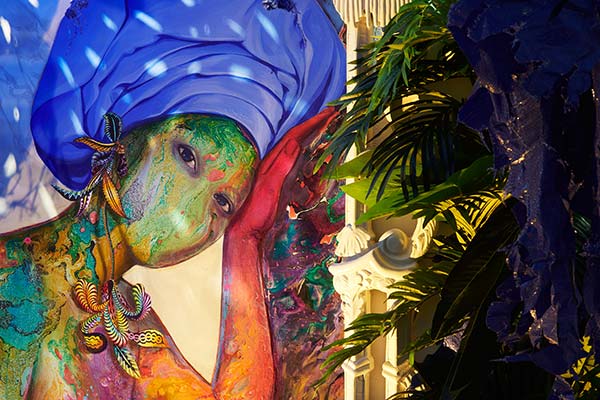Spring 2019 Highlights
By Emilia Dubicki, WTP Art Correspondent
Four times a year, WTP art correspondents from around the country will report back on the previous season, with images from exhibitions you otherwise might have missed, and their own insights into these varied venues.
For several years now, galleries have been opening in or relocating to Chinatown and the Lower East Side of Manhattan. Between the produce stands of tangerines and mangoes and the plant stores with flowering hibiscus, you will find contemporary fine art—an unexpected juxtaposition, but it works.
In this mix, at 87 Eldridge Street, is the Milton Resnick and Pat Passlof Foundation, housed in Resnick’s former studio, which was also once a synagogue. The current exhibit Doing What Comes Naturally: Seven Painters in Their Prime, up through August 4th, features abstract work by Riley Brewster, Denzil Hurley, John Obuck, Nathlie Provosty, Rebecca Purdum, Joyce Robins, and Andrew Spence. The show occupies the first and fourth floors of this beautifully renovated building. The second floor, with its soaring windows, is dedicated exhibition space for Resnick’s paintings. In keeping with the Foundation’s mission of supporting mature artists, curator Robert Storr has assembled a group of works that seamlessly interact with one another, creating inroads between the various artists in this thoughtfully installed show. Storr writes of these artists: “The one thing that they all have in common, and share with the patrons of this new institution, is that they have been committed painters during periods when painting has died a thousand deaths….”
The commitment of these seven painters is evident. Entering the space from the busy street, serenity prevails with Nathlie Provosty’s large geometric 2018 oil on linen abstract “Therefor,” in warm blacks and grays. The surface is divided into six sections, and as the straight edges and curves guide you around the painting, you see that the alignment is slightly off. There’s gradation from lighter to darker as the painting fades into night at the top, and shapes and dark hues emerge in the back-and-forth imagery.
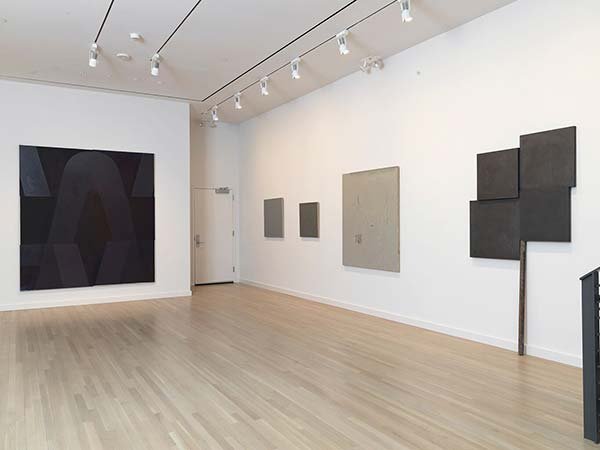
Courtesy Milton Resnick and Pat Passlof Foundation
Denzil Hurley’s “Glyph Within, Without and About #9,” is diagonally across from Provosty’s painting, and the shape-shifting continues in his four charcoal dark canvases. Seemingly monochromatic from one angle, viewed from another, subtle gradations are revealed. Dark rectangular shapes also float in Hurley’s painting “Redact-2,” leaving the viewer wondering what has been redacted on this wheat-colored canvas.
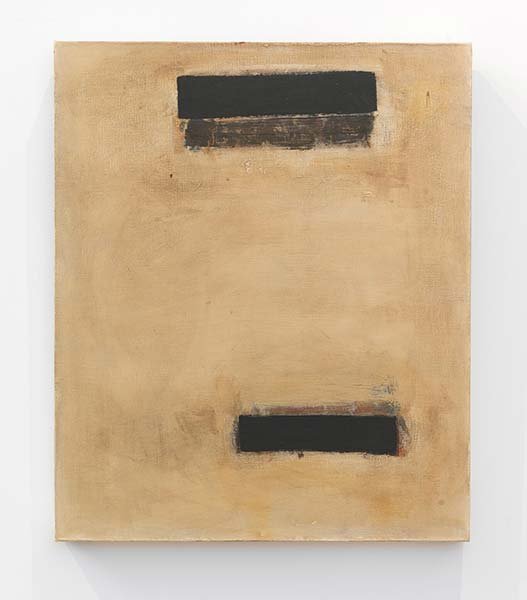
Image credit: Brian Buckley. Courtesy Milton Resnick and Pat Passlof Foundation
Rebecca Purdum’s paintings seem to reference nature, with subtle marks emerging from beneath the murky earth-toned surfaces. In the darkness of “Raft,” blue, red, and off-white paint forms an underbrush, or perhaps reflection and ripples on water. Partially obscured marks hover near the surface. Riley Brewster’s earthy browns, grays, and tans lend his paintings a spackled mortar feel. Tiny windows of lighter color in each painting are suggestive of other worlds thriving beneath the surface.
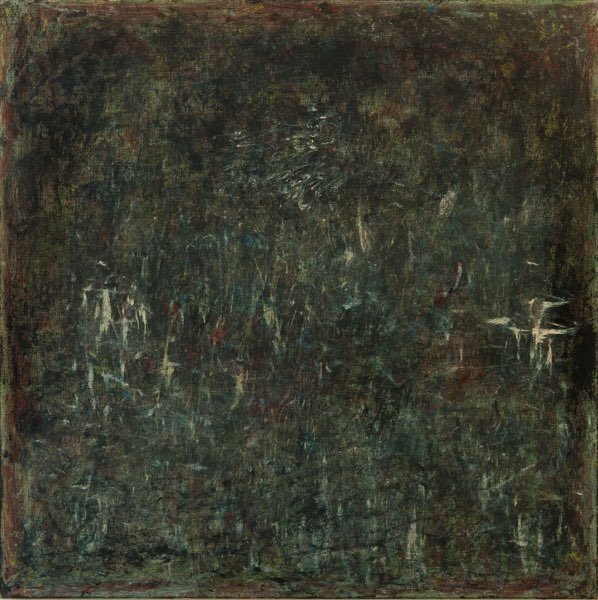
Image credit: Jonathan Blake. Courtesy Milton Resnick and Pat Passlof Foundation.
Squares and rectangles take precedence in the first floor works, and these paintings seem to continue beyond their unframed canvases, with themes of emergence, obscurity, and illusion. The show continues in the fourth floor gallery, where there is a distinct relationship between color and shape. Painted borders frame John Obuck’s work of rounded forms. Andrew Spence’s paintings appear 3-D, with a play on line and borders, and with yellow set against orange, pink against turquoise. In Joyce Robins’s shape-covered canvases, each shape is outlined in a contrasting color. I thought of her four paintings as representing the seasons. Yellows, violets, and other colors in one artist’s paintings are echoed in the next artist’s work – lines, shapes, colors all weaving Obuck, Spence, and Robins together.
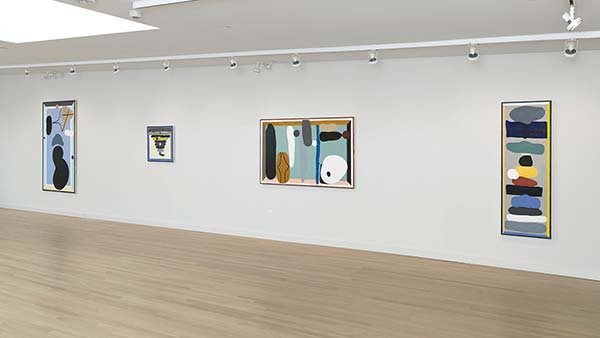
Courtesy Milton Resnick and Pat Passlof Foundation
Across the street from the Resnick Passlof Foundation, David Lewis at 88 Eldridge Street is showing Todd Gray’s photographic images in Cartesian Gris Gris. Gray, who lives in Los Angeles and Ghana part year, is also currently included in the Whitney Biennial. His works are combinations of framed, overlapping photographic images, forming assemblages of contrast. Some frames are handmade, others purchased from thrift stores, and they range from simple to gold and ornate. The layering of the various-sized framed images gives Gray’s work a sculptural feel. Photographs of royal and imperial European formal gardens are contrasted with the more natural and rural of Ghana and South Africa. Worlds of the colonizers and colonized are at once united and separated by frames in Gray’s binary compositions.
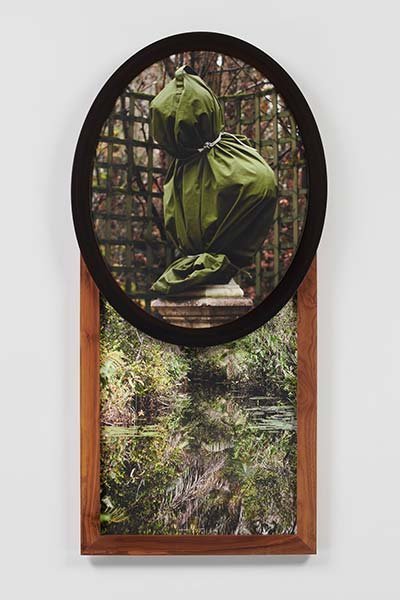
Courtesy the artist and David Lewis, New York
In several photographs, figures are cropped or obscured. In some cases, images are turned, adding an additional layer of abstraction. The effect is collage-like but also highlights the differences of worlds in opposition to one another. In “Cartesian Gris Gris (Water),” a formal fountain in a manicured garden has fallen on its side, in an overgrown landscape of yellowing palms reflected in water. Again, things are redacted and the viewer is left to fill in missing faces and facades. Gray worked for years as a photographer of jazz, rock, and pop musicians, and there is a musical quality to this exhibit, in the compositions of the individual works and in the overall collection. The photographs overlap like sounds, are isolated in their frames like notes, and expand like broader passages of music from one piece into another.
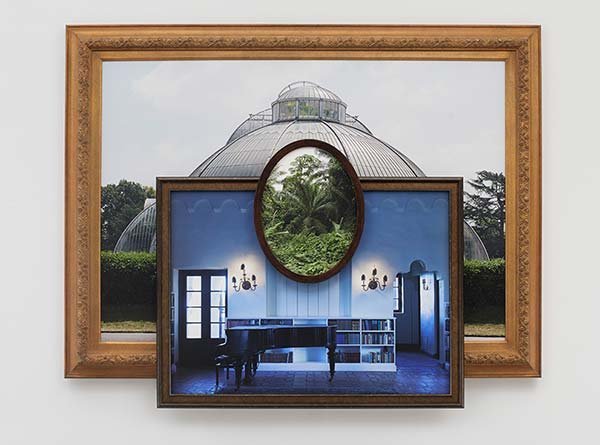
Courtesy the artist and David Lewis, New York
A highlight of this exhibit is the recreation of a wall in Gray’s studio in Akwidaa, Ghana. The wall, a collaboration between the artist and architect Peter Tolkin of TOLO Architecture, serves as a canvas for Gray’s on-site charcoal drawings. Painted white like the gallery walls, it subtly divides the gallery space; where the photographic pieces on the gallery walls are full of color, the recreated wall provides a different space to reflect on, imbuing the formal gallery setting with a bit of Ghana.
On the corner of Eldridge and Grand Streets, at the James Cohan gallery, is Firelei Báez: A Drexcyen Chronocommons (To win the war you fought it sideways), an immersive show by Dominican-born, New York–based artist Firelei Báez. In the front room hangs a large blue tattered and perforated tarp, as if there were ongoing construction. The tarp, I learned, is symbolic of temporary shelter, and on a bench is a group of books—Junot Díaz, Edwidge Danticat, among the authors—hinting at what burgeons beyond the suspended tarp. The main gallery is transformed by small white ceiling lights, positioned in the way stars appeared at the onset of the Haitian Revolution. The space is tented in blue hand-perforated tarp and billowy blue material printed with diasporic symbols.
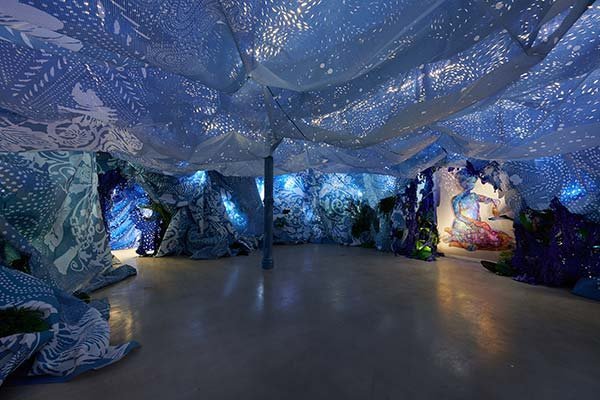
© Firelei Báez. Image courtesy the artist and James Cohan, New York. Photo by Phoebe d’Heurle.
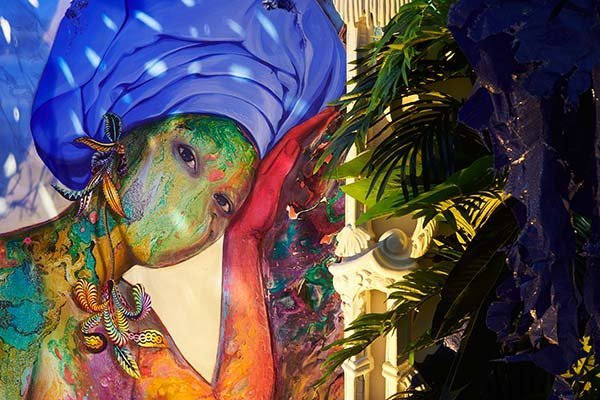
© Firelei Báez. Image courtesy the artist and James Cohan, New York. Photo by Phoebe d’Heurle.
Two large portraits referencing Haitian priestesses face one another across the space, the viewer caught between their intense gazes. They are illuminated and flanked altar-like with plants and the ornamental. One of the women has multiple hands and legs painted in swirling fluidity, perhaps in reference to movement, but also to evoke the limbs of her ancestors. The faces are a wash of watery aqua, golden yellows, purples, and magentas; only the eyes are clear and penetrating. The artist weaves together various diasporic narratives, and as we exit this environment, blue tarp spills into the final gallery hung with printed canvases—snaky, calligraphic forms and two amulets of black hands are painted over one blue print. On another, a map of the “Caribbee Islands” is the backdrop. In “An open horizon (or the stillness of a wound),” figures covered in tropical flowers wrestle on a blueprint of a bayou bridge. A wave of watery paint splashes across the large canvas. With intricately painted details, Báez examines natural and cultural beauty, struggle, histories, relocation, and the overlap and mix of these narratives and memories. (Báez also has a sculpture depicting a Haitian Sans-Souci Palace ruin installed on the High Line at 20th Street as part of the 2019 “En Plein Air” art exhibition.)
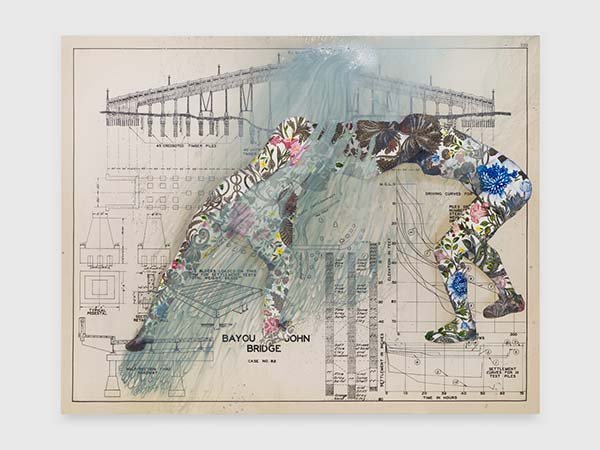
© Firelei Báez. Image courtesy the artist and James Cohan, New York. Photo by Phoebe d’Heurle.
Just down from James Cohan on Grand Street, I stopped in the Marc Straus gallery to see an exhibit of recent paintings by Austrian artist Hermann Nitsch. Nitsch, now eighty years old, is a co-founder of the 1960’s Viennese Actionism movement and the creator of the Theatre of Orgies and Mysteries, featuring radical, ritualistic performance art. Nitsch’s art is still about blood and guts, religious symbolism, a sensory experience reminding us of our humanity and mortality.
Nitsch calls his method Painting Action, and he smears and manipulates the thick blues, yellows, greens, and reds with his hands. The paintings have the titles of “Schüttbild,” with schütt being German for rubble. Nitsch’s impasto surfaces are alive with evidence of the artist’s hands. Under the skylights, the rich yellow paintings hung like suns, announcing spring’s rejuvenation and the Easter season’s resurrection. Was the ascension to the top floor to view these works symbolic of a higher plane filled with light?
Affixed to each of two yellow paintings was a white t-shirt on a wooden bar. The t-shirts were incorporated into the canvases, caked in paint and finger marks. They hung as if crucified on a cross, and yet they were simple white t-shirts symbolic of every man. In the past, Nitsch’s T-shirts have been painted in blood red, or in blacktop to resemble charred remains. In stark contrast, these yellow paintings resonate with new life.
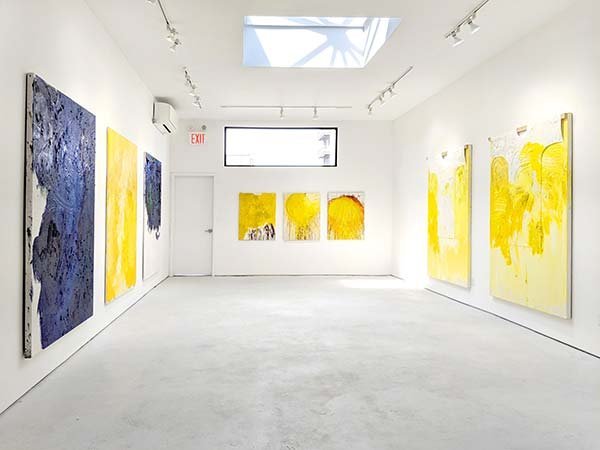
Photo by Ken Tan. Courtesy of Marc Straus, New York.
A painting in rich cobalt blues was a collision of deep ocean and evening sky. A splattered red painting, hanging away from the grouping of yellows and blues, was viscerally intense, with big swipes and splashes of crimson. I thought of life and death, and yet, still saw a bold abstract expressionist work reminding me of Kazuo Shiraga’s work painted with the artist’s feet. With each new painting, is this an exertion of energy accompanying its creation a kind of rebirth?
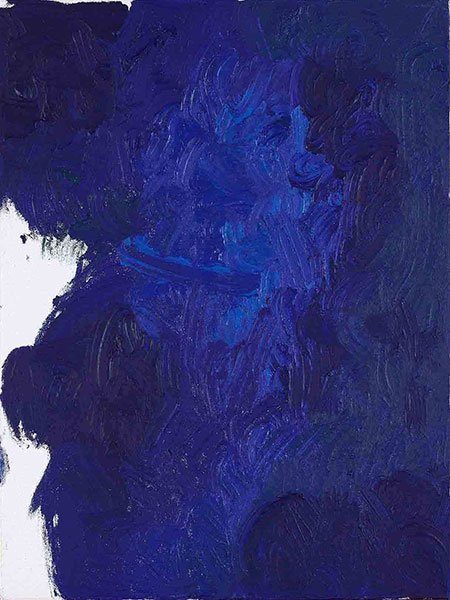
Photo by Ken Tan. Courtesy of Marc Straus, New York.
Visiting these exhibitions on the Lower East Side, I walked the streets of Chinatown where I could not read the storefront signs, I had to rely on a more intense way of seeing. I took in the colors, symbols, sounds, and crowded sidewalks the way I look at art—letting the imagery speak for itself. In a neighborhood where many of the inhabitants have journeyed from far off places, these artists helped to bridge the distance, making connections at once grounded and timeless.
If you are interested in becoming an art correspondent for WTP, please inquire at wtp@thewoventalepress.net
Copyright 2019 Woven Tale Press LLC. All Rights Reserved.

